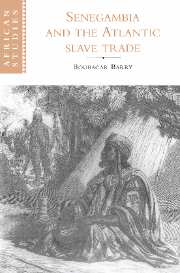Book contents
- Frontmatter
- Contents
- Preface
- Map
- I Senegambia from the fifteenth to the seventeenth century: a haven for incoming populations, a station for migrants on the move
- II Senegambia in the eighteenth century: the slave trade, ceddo regimes and Muslim revolutions
- 5 The slave trade in the eighteenth century
- 6 The strengthening of ceddo regimes in the eighteenth century
- 7 Muslim revolutions in the eighteenth century
- 8 The impact of the slave trade: economic regression and social strife
- III Senegambia in the first half of the nineteenth century: legitimate trade and sovereignty disputes
- IV Senegambia in the second half of the nineteenth century: colonial conquest and resistance movements
- Conclusion
- Notes
- Bibliography
- Index
- Other books in the series
8 - The impact of the slave trade: economic regression and social strife
Published online by Cambridge University Press: 31 October 2009
- Frontmatter
- Contents
- Preface
- Map
- I Senegambia from the fifteenth to the seventeenth century: a haven for incoming populations, a station for migrants on the move
- II Senegambia in the eighteenth century: the slave trade, ceddo regimes and Muslim revolutions
- 5 The slave trade in the eighteenth century
- 6 The strengthening of ceddo regimes in the eighteenth century
- 7 Muslim revolutions in the eighteenth century
- 8 The impact of the slave trade: economic regression and social strife
- III Senegambia in the first half of the nineteenth century: legitimate trade and sovereignty disputes
- IV Senegambia in the second half of the nineteenth century: colonial conquest and resistance movements
- Conclusion
- Notes
- Bibliography
- Index
- Other books in the series
Summary
There is no doubt that the slave trade was the basic business of the Atlantic trading system from the seventeenth century to the nineteenth. Throughout this long period, the selling and buying of human beings, direct producers of goods, determined relations between Senegambia and the European powers. It also determined the nexus of economic, political, and social relationships within the region's various states.
The slave trade and its corollary, warfare between the Senegambian states, were a permanent part of a situation of chronic violence imposed within each state by the existence of a military aristocracy reigning above peasant populations, potential victims of slave raids. Slave trading became a royal monopoly based on violence. As such, it prevented the peasant population working productively under secure conditions.
The result was economic regression. Evidence that this was the state of affairs in all domains can be deduced from the innumerable famines punctuating the history of Senegambia throughout the long slaving era. The famines were caused sometimes by warfare, at other times by natural disasters, the consequences of which aggravated the population drain caused by the massive export of producers as slaves. On the domestic level, the slave trade deepened habits of servility in relationships between free men and slaves. Domestic slavery became an integral complement to the Atlantic slave trade.
In northern Senegambia, royal slaves became instruments serving the arbitrary power of ceddo regimes.
- Type
- Chapter
- Information
- Senegambia and the Atlantic Slave Trade , pp. 107 - 126Publisher: Cambridge University PressPrint publication year: 1997

